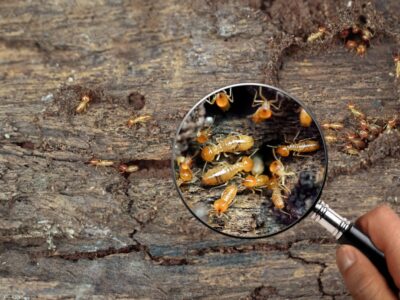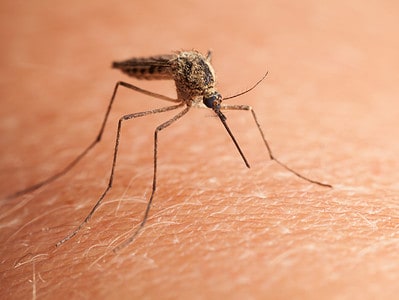Corn Rex Cat (Cornish Rex)
Felis catus
Advertisement
Corn Rex Cat (Cornish Rex) Scientific Classification
- Kingdom
- Animalia
- Phylum
- Chordata
- Class
- Mammalia
- Order
- Carnivora
- Family
- Felidae
- Genus
- Felis
- Scientific Name
- Felis catus
Read our Complete Guide to Classification of Animals.
Corn Rex Cat (Cornish Rex) Conservation Status
Corn Rex Cat (Cornish Rex) Facts
- Diet
- Omnivore
- Common Name
- Corn Rex
View all of the Corn Rex Cat (Cornish Rex) images!
The Cornish Rex, also called Corn Rex, is a domestic cat breed that originated from a genetic mutation that caused it to have no fur, only down hair that is very fine and wavy. Also known as the Gazelle, Greyhound, or Whippet of cats, it has a long, athletic, curved body, wide hips, and a social, intelligent, affectionate, trainable personality.
Cornish Rex Traits: What to Know Before You Buy
- The Corn Rex personality is very active, curious, and social, and therefore needy in terms of companionship and attention. This breed isn’t recommended for people who want a more solitary, independent cat.
- Contrary to popular belief, the Corn Rex is not hypoallergenic, but it has minimal shedding. People who are allergic to pet dander are less sensitive to this breed.
- This breed has more risk of skin problems such as rashes and sunburn because it doesn’t have an outer coat to absorb natural oils and protect the skin. Special care must be given to properly protect and wash its skin.
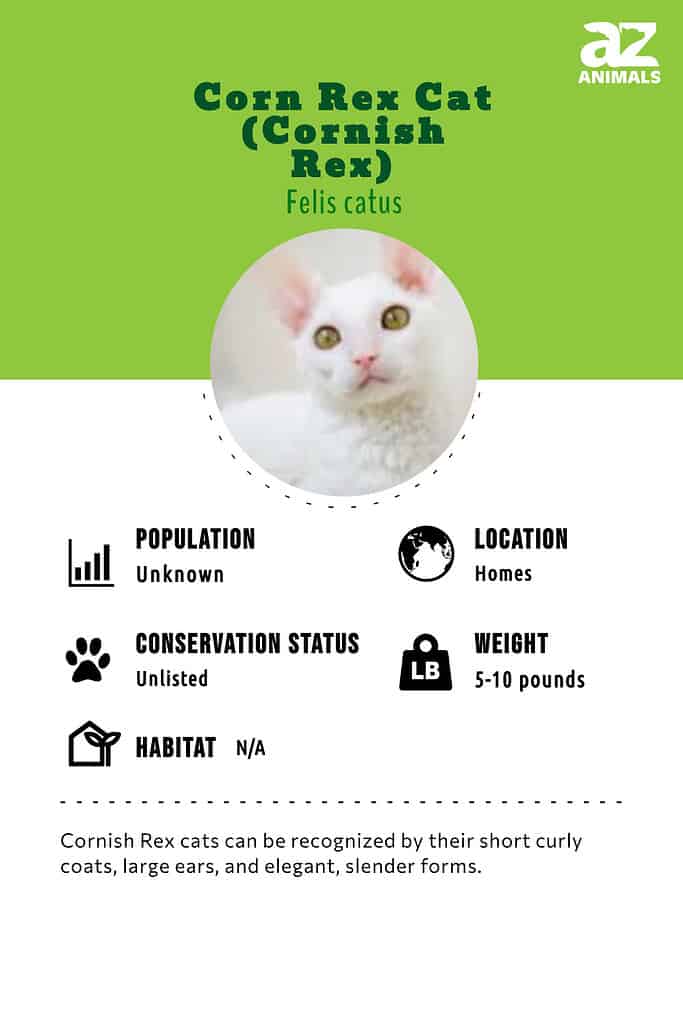
Origins
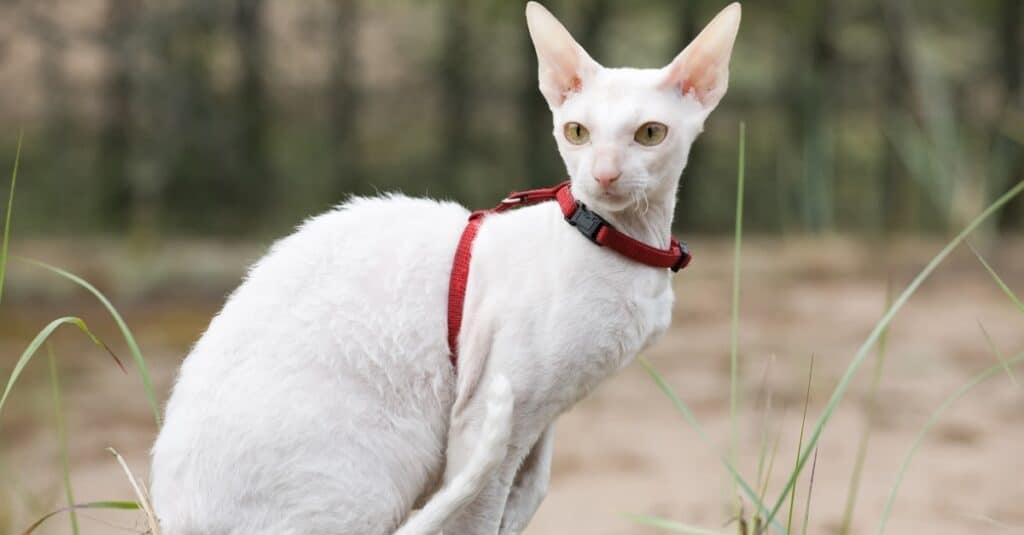
Cornish Rex cats are descended from American and British shorthair cats,
See all of our expert product reviews.
Burmese
, Havana Brown, Siamese, and other breeds
©Oleg Kozlov/Shutterstock.com
The story of the Cornish Rex dates back to the 1950s. A British shorthair belonging to certain Nina Ennismore, of Cornwall birthed a kitten which had a short curly coat and a slender, long-limbed build.
The pet was named Kallibunker and its descendants subsequently mixed with British shorthairs, Burmese, and Siamese. However, in spite of the original owner’s earlier desire to continue the breed, the population all but vanished from her home country by the close of the decade.
Health and Entertainment for your Corn Rex Cat (Cornish Rex)
See all of our expert product reviews.
Fortunately a couple of them had been shipped to the States. There they were further crossed with a selection of other breeds including the American shorthair and the Havana Brown. And by the middle of the following decade, the Cornish Rex was recognized by the Cat Fancier’s Association.
Personality
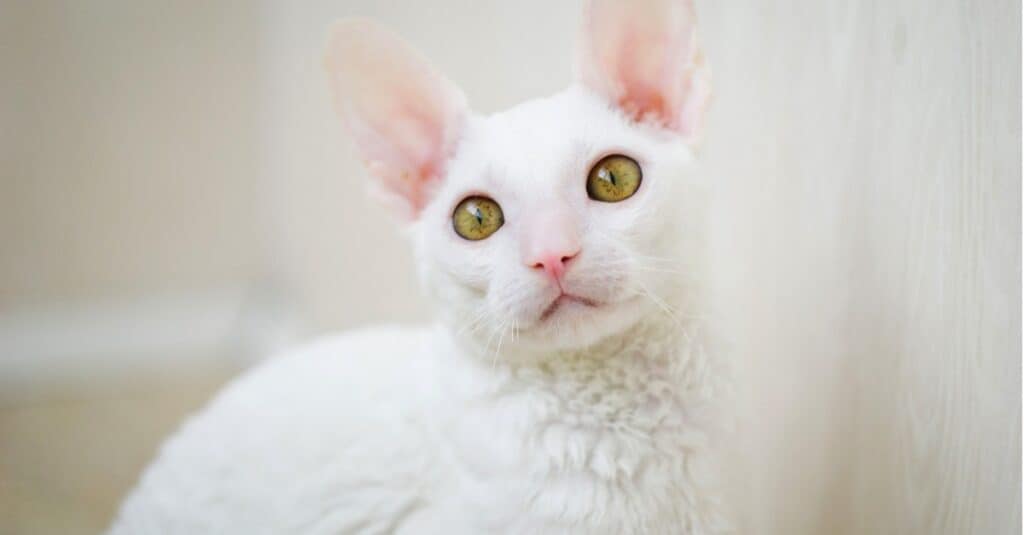
The Cornish Rex has a playful, energetic, and affectionate nature which belies its slender elegance
©iStock.com/aliven
This breed’s personality is social, mischievous, adventurous, curious, playful, and affectionate. It has a charismatic, energetic, adaptive, and trainable temperament. If you’re looking for a cat that gets along well with strangers, children, other cats, and other pets, the Corn Rex is a winner, as it seeks out company.
This breed is athletic. Although it looks fragile, it has a sturdy, muscular body and a running gallop. A natural acrobatic, it enjoys jumping long or high distances. It also enjoys playing fetch and racing other pets, and even walking on a leash.
Because of its light coat, it must be kept indoors and in warm, dry temperatures. This cat enjoys warm spots such as human laps and shoulders, lamps, and computer monitors.
Size and Weight
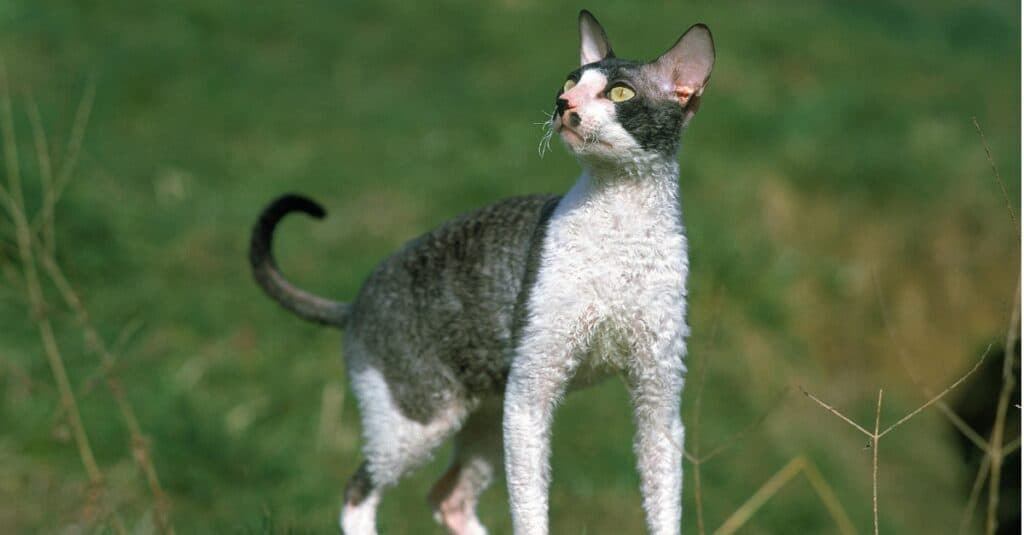
©iStock.com/slowmotiongli
The Corn Rex is a long, slender, thin-coated medium-sized breed. It weighs five to ten pounds, which is a small weight range, and it shouldn’t exceed ten pounds. It is 11-15 inches high with a body length of 12-17 inches. Males weigh eight to ten pounds, while females weigh six to eight pounds.
The breed has a long tail. It is one of the breeds with the longest tails. Other qualities that make people pay attention are its large ears, slightly upward-slanting oval-shaped eyes, egg-shaped egg, curved and muscular body, and wide hips.
If you’re looking for cat breeds that are similar in body type, size, and weight to Corn Rex, the Oriental Shorthair, Sphynx, and Devon Rex share oversized ears and other physical features. The Oriental Shorthair has an outer coat, while the Sphynx is a little shorter and smaller. The Devon Rex is shorter but longer.
Price
The price for an adult Corn Rex from a breeder is around $950. There are also Cornish Rex rescues, with the price for a cat or kitten being the adoption fee.
Kittens
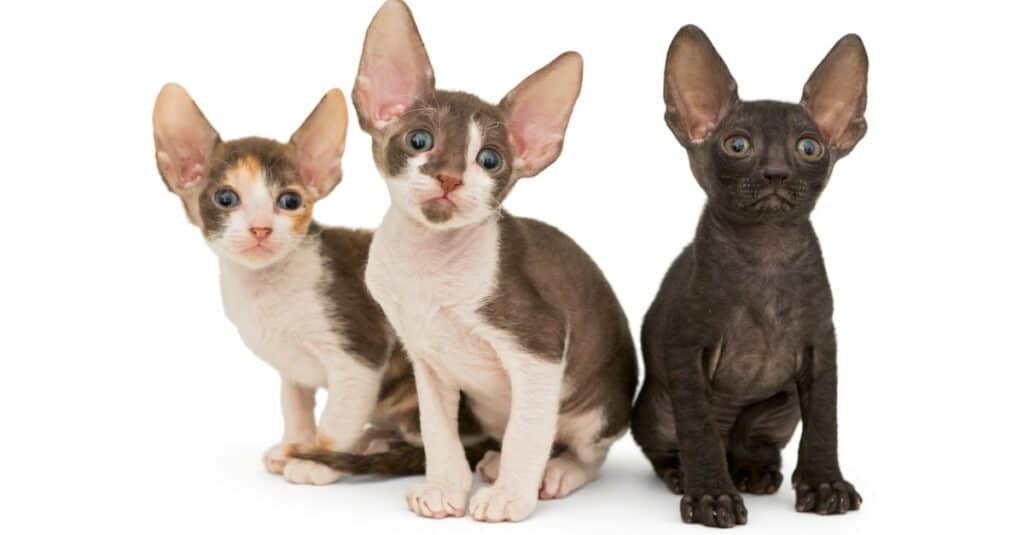
Cornish rex kittens grow pretty fast and are sociable and friendly
©iStock.com/Okssi68
Corn Rex kittens retain their playful, kittenish energy as they age and even into adulthood. Their temperament as kittens is what prospective owners can expect them to have their whole lives. Their hyper, social, and lovable personalities make them ideal for families with children, other cats, and even other pets, such as dogs.
This breed is a medium-sized cat that reaches puberty at five to ten months. It gets close to its full-grown size and weight at nine to 12 months, after which it grows much more slowly until 18 months.
The price of a Corn Rex kitten can be anywhere from $800 to $1,300. A pet-quality kitten has a lower price than that of a show-quality kitten. Kittens are completely weaned at six weeks, which is the earliest age you can safely adopt them.
Lifespan
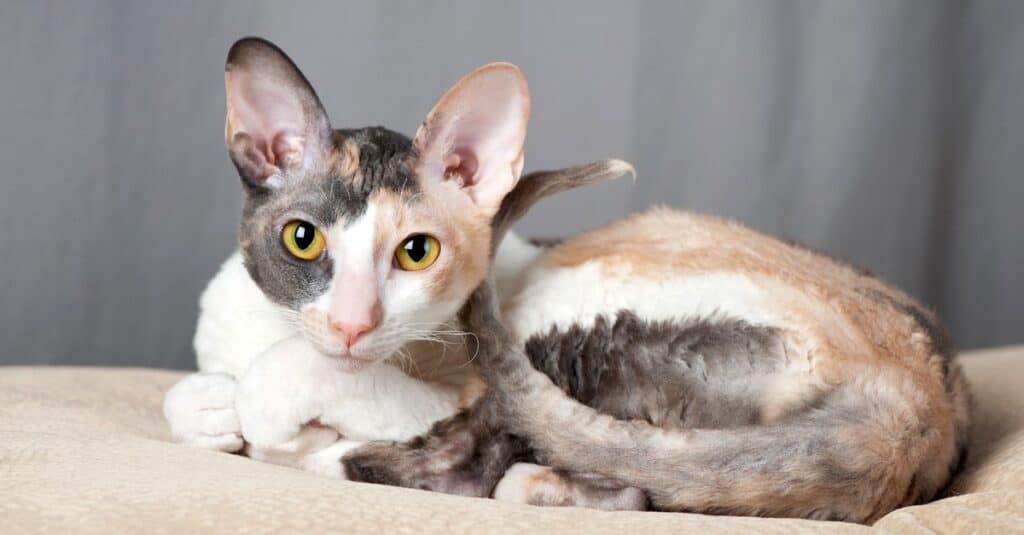
Cornish Rex cats generally live between 12 – 15 years although they are capable of living for up to 20 years
©Marina Shanti/Shutterstock.com
The Corn Rex lifespan is 11-20 years with an average of 12-15 years. Compared to an average lifespan of nine to 12 years, this breed lives a long time.
Breed vs. Mixed
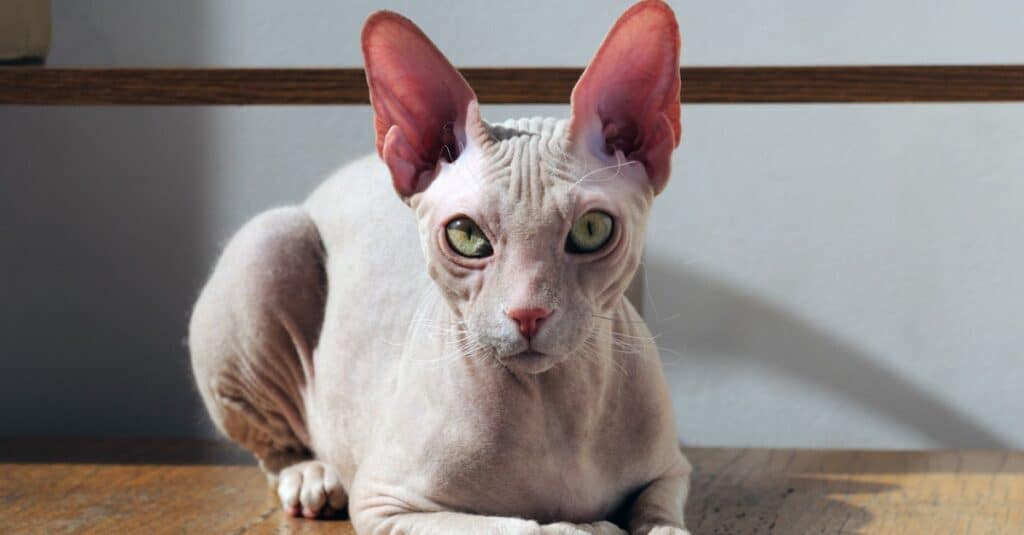
Mixed Cornish Rex cats come with variations in their features, personalities, and colors
©iStock.com/Aleksandr Shulichenko
Purebred Corn Rexes have a consistent temperament, personality, colors, lifespan, length, height, weight, and other features. Mixed Corn Rex cats have differences in physical features, personality, colors, and other features depending on the breed used for crossing. They also tend to have outer coats and far fewer skin problems.
Types of Cornish Rex Cats and Colors
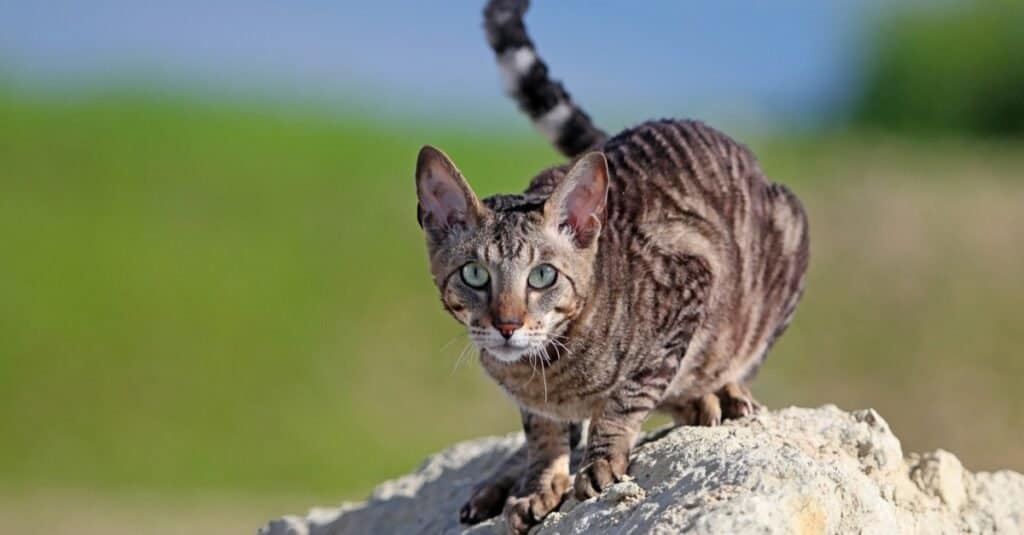
The Cornish Rex comes in a wide array of colors and coat patterns
©DragoNika/Shutterstock.com
The Corn Rex breed standard colors are:
- White with pink nose and paw pads, and blue or golden eyes
- Black with black noses, brown or black paw pads, and golden eyes
- Blue with blue/grey nose and paw pads, and golden eyes
- Red with red nose and paw pads, and golden eyes
- Light cream with pink nose and paw pads, and golden eyes
- Chocolate brown with brown nose, pink paw pads, and golden eyes
- Lighter silver or darker black-tipped silver, both with red noses, black paw pads, and green/blue eyes
- Tipped color variations with pink, brown, or black noses and paw pads depending on the base color, all with golden eyes
Corn Rex coat patterns are:
- Tabby: Common dark stripes or Spotted Tabby and Patched Tabby variations
- Tortoiseshell: Mixed, large patches of two different colors (non-white) with golden eyes
- Calico: Two different patches of black, red, chocolate, smokey, or lavender, against a white base, usually red and black
- Bicolor: Solid color on white background
- Pointed: Point coloration with pale bodies and darker extremities or ‘points’
Cornish Rex vs. Devon Rex
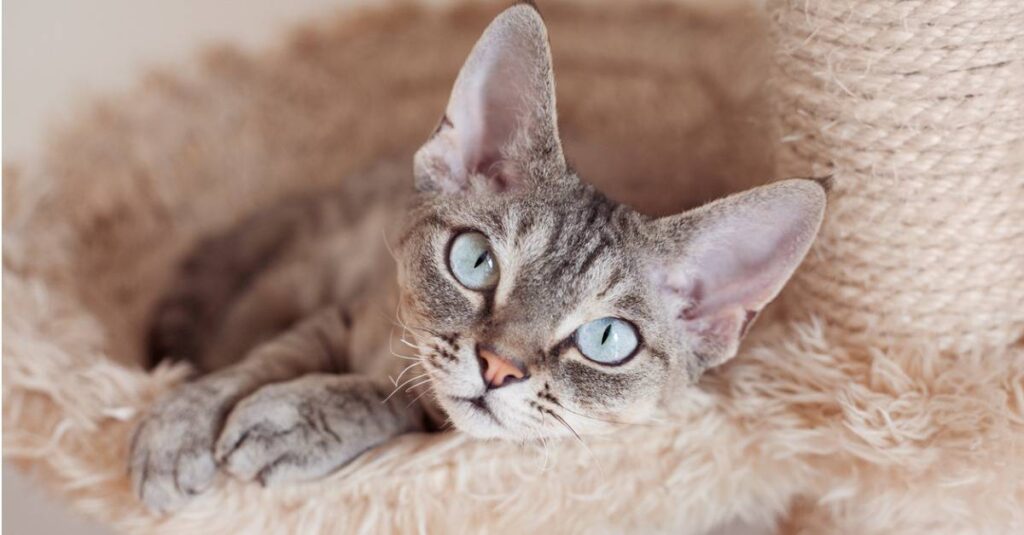
The Devon Rex is somewhat similar to the Cornish Rex although it is less outgoing and has a shorter lifespan
©iStock.com/insonnia
Perhaps the biggest traits these two different breeds share are that they both originated in the United Kingdom and have large ears and curly, soft coats. However, facts also show that they are also of similar weight, the same litter size, and are low-maintenance breeds. The Devon Rex has a shorter lifespan, while the Corn Rex is more outgoing and territorial.
View all 235 animals that start with CCorn Rex Cat (Cornish Rex) FAQs (Frequently Asked Questions)
Is my cat a Cornish Rex?
The easiest way to tell a Cornish Rex is by its unique physical features. You should also check out the breed standard of size, weight, colors, and temperament.
Are Cornish Rex cats aggressive?
No, they are not aggressive once they have adjusted to their new home.
What is Cornish Rex mix of?
The original curly-coated kitten was birthed by a tortoiseshell and white mother. It was then bred back to its mother and their offspring were developed into the Cornish Rex by crossing with domestic shorthairs, American Shorthairs, British Shorthairs, Siamese, Russian Blues, Havana Browns, and even some Devon Rexes.
Are Cornish Rex good for pets?
Yes, Cornish Rexes are good for pets and get along with other pets. They prefer company!
Are Cornish Rex cats high maintenance?
No, Corn Rexes are actually low-maintenance with minimal shedding, and once you understand how to easily prevent skin problems.
Are Cornish Rex hyper?
Yes, one of the facts about these cats is that they are hyper.
Are Cornish Rex hypoallergenic?
No, the breed is not hypoallergenic but people who are allergic to pet dander are less sensitive due to its lack of fur.
Do Cornish Rex cats shed?
Yes, but having only fine down hairs means they have minimal shedding compared to other breeds.
What are the differences between Devon Rex and Cornish Rex?
Both are famous for their playful nature as well as their super-soft coats. However, despite the similarities, there are actually a few differences between the Devon Rex and the Cornish Rex – particularly the shape of their faces and ears.
Thank you for reading! Have some feedback for us? Contact the AZ Animals editorial team.
Sources
- Wikipedia, Available here: https://en.wikipedia.org/wiki/Cornish_Rex
- The Cat Fancier's Association, Available here: https://cfa.org/cornish-rex/
- petfinder, Available here: https://www.petfinder.com/cat-breeds/cornish-rex/
- holistapet, Available here: https://www.holistapet.com/cat-breeds/cornish-rex-cat/
- AnnieMany, Available here: http://www.anniemany.com/2013/09/cornish-rex-cat-historysize-and-weight.html
- ExcitedCats, Available here: https://excitedcats.com/types-of-cornish-rex-cats/
- MyCatBreeds, Available here: https://www.mycatbreeds.com/devon-rex-vs-cornish-rex
- catster, Available here: https://www.catster.com/lifestyle/cat-breeds-cornish-rex-personality-ballet-dancer-body-pictures-photos









